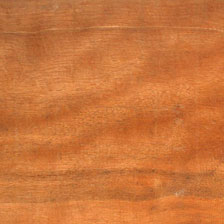Bilinga

Other names
Akondoc, Badi, Opepe
Scientific Name
Nauclea diderrichii
Family
Rubiaceae
Description
Bilinga is characteristic for its yellow or aureate colour which darkens with time. The heartwood is a golden-yellow or orange-brown colour that is clearly defined from the sapwood which is pinkish yellow and about 50 mm wide. It darkens on exposure. The texture of this timber is coarse and the interlocked grain is frequently used to produce a striped figure on quarter-sawn surfaces. without characteristic odor or taste. An alkaloid in the wood may be toxic to woodworkers.
Density
(H=12%) : 0,76
Treatability
moderately permeable
Seasoning
Bilinga will dry slowly with little checking or warp
Stability
Moderately stable
Durability
Heartwood is rated as very durable but is moderately resistant to termites
Workability
Timber works moderately well with hand and machine tools, requires a slow feed in sawing, a 10-degree cutting angle is suggested for planing prevent tearing; good gluing; takes a satisfactory finish. Poor steam- bending characteristics.
End-Uses
- Sleepers
- Heavy carpentry
- Poles
- Bridges (parts in contact with water or ground)
- Hydraulic works (seawater)
- Vehicle or container flooring
- Industrial or heavy flooring
- Flooring
- Cabinetwork (high class furniture)
- Current furniture or furniture components
- Ship building (planking and deck)
- Exterior panelling
- Interior joinery
- Interior panelling
- Bridges (parts not in contact with water or ground)